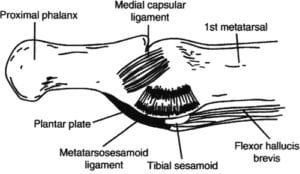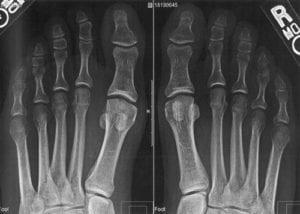 Turf toe is a condition that occurs in the hallux metatarsophalangeal joint (Hallux MTP joint) due to hyperextension of the medial capsular ligament. Common symptoms include soreness of the areas around the plantar plate, dislocation of the joint, or surface disruption of the metatarsal, all of which result in swelling and bruising. From a medical perspective many of these soft tissue structures are disrupted as the anteroposterior, lateral, and sesamoid axial radiographs display abnormal sesamoid retraction.
Turf toe is a condition that occurs in the hallux metatarsophalangeal joint (Hallux MTP joint) due to hyperextension of the medial capsular ligament. Common symptoms include soreness of the areas around the plantar plate, dislocation of the joint, or surface disruption of the metatarsal, all of which result in swelling and bruising. From a medical perspective many of these soft tissue structures are disrupted as the anteroposterior, lateral, and sesamoid axial radiographs display abnormal sesamoid retraction.
Depending on the severity of the injury, full recovery may take up to 8 weeks. However, acknowledgement of the issue during its early stages will result in faster recovery. First, the inflammation and pain of the toe is treated with ice, compression, rest from vigorous activities and elevation. Then, a walking boot or short leg cast may be used to prevent further injury and promote healing of the soft tissues. From there, the turf toe condition is split into three categories.
The first grade of severity is when the plantar structures of the hallux MTP joint are stretched. First, tape is used in an acutely plantar-flexed direction to reduce movement of the the joint and compression. A custom made or stiff shoe sole that may include the Morton’s extension are also used to support the hallux joint and reduce its movement. Then, after three to five days of rest, the patient may participate in activities with little foot movement or pressure accompanied by close monitoring of their healing progress to prevent further injury.
The second grade of injury occurs when the soft tissue structures of the joint are broken and must be left to heal for at least two weeks before passive plantar-flexed activities can begin again.  However, the toe must be protected with taping and joint support from orthotic soles to allow for its healing as patients progress to exercises that require vigorous movement of the ligament.
However, the toe must be protected with taping and joint support from orthotic soles to allow for its healing as patients progress to exercises that require vigorous movement of the ligament.
The most serious condition is the full rupture of the hallux MTP joint. An immobilization period of up to 8 weeks is to be expected along with a requirement of 50° to 60° of dorsiflexion from the joint before attempting any rigorous movement.
Nonetheless, careful follow-up of a patient’s progress in healing and early acknowledgement of the issue assures a full recovery.
Source:
Bowman, M. W. (1996). [Medial view of the hallux metatarsophalangeal joint.]. Retrieved July 14, 2017, from https://www.ncbi.nlm.nih.gov/pmc/articles/PMC3438874/figure/fig1-1941738110386681/
McCormick, J. J., & Anderson, R. B. (2010, November). Turf Toe: Anatomy, Diagnosis, and Treatment. Retrieved July 14, 2017, from https://www.ncbi.nlm.nih.gov/pmc/articles/PMC3438874/
McCormick JJ, Anderson RB (2010). [Orthotic options for turf toe injury: A, carbon-fiber turf toe plate*; B, custom orthotic with Morton’s extension.]. Retreived July 14, 2017, from https://www.ncbi.nlm.nih.gov/pmc/articles/PMC3438874/figure/fig8-1941738110386681/